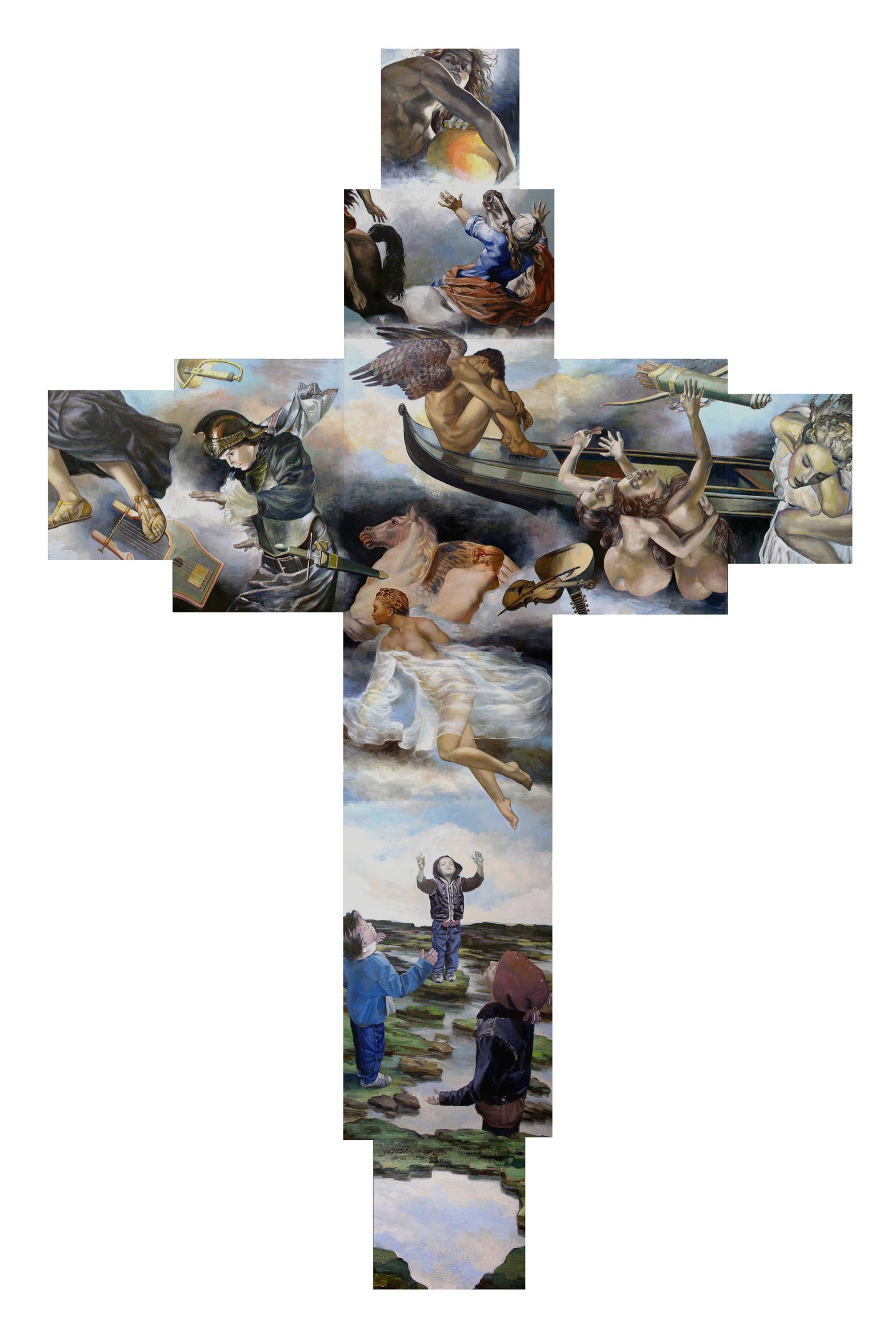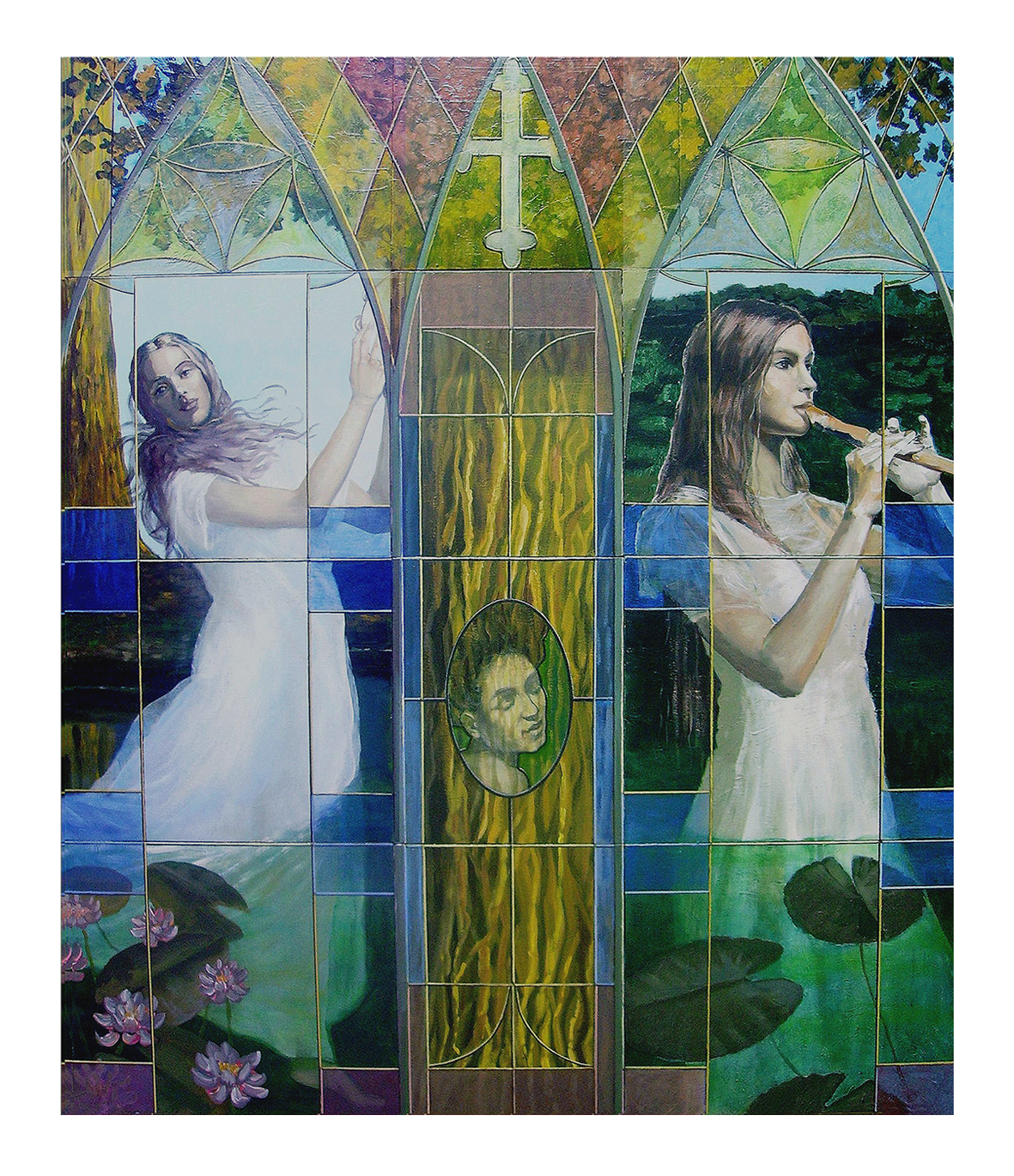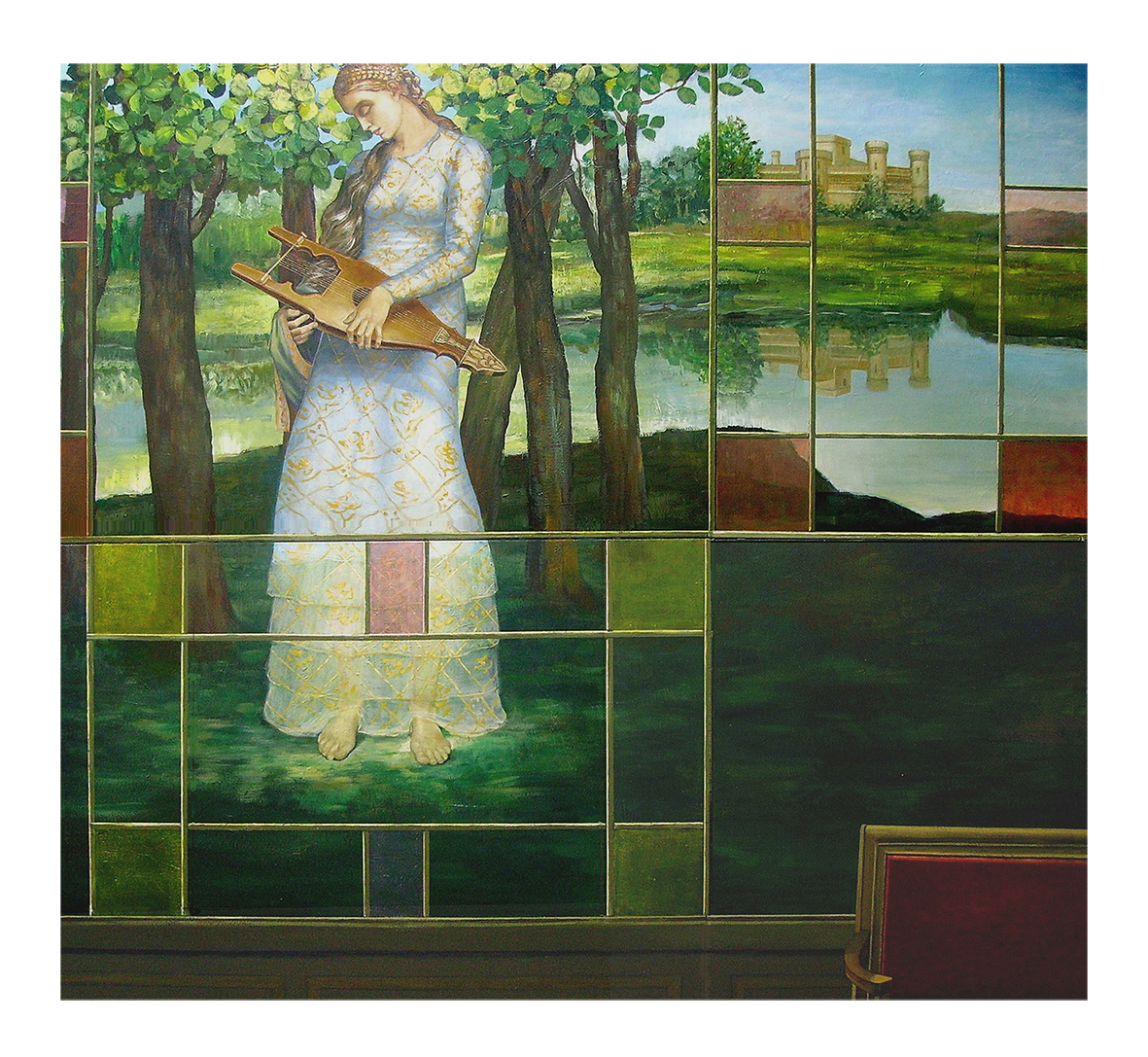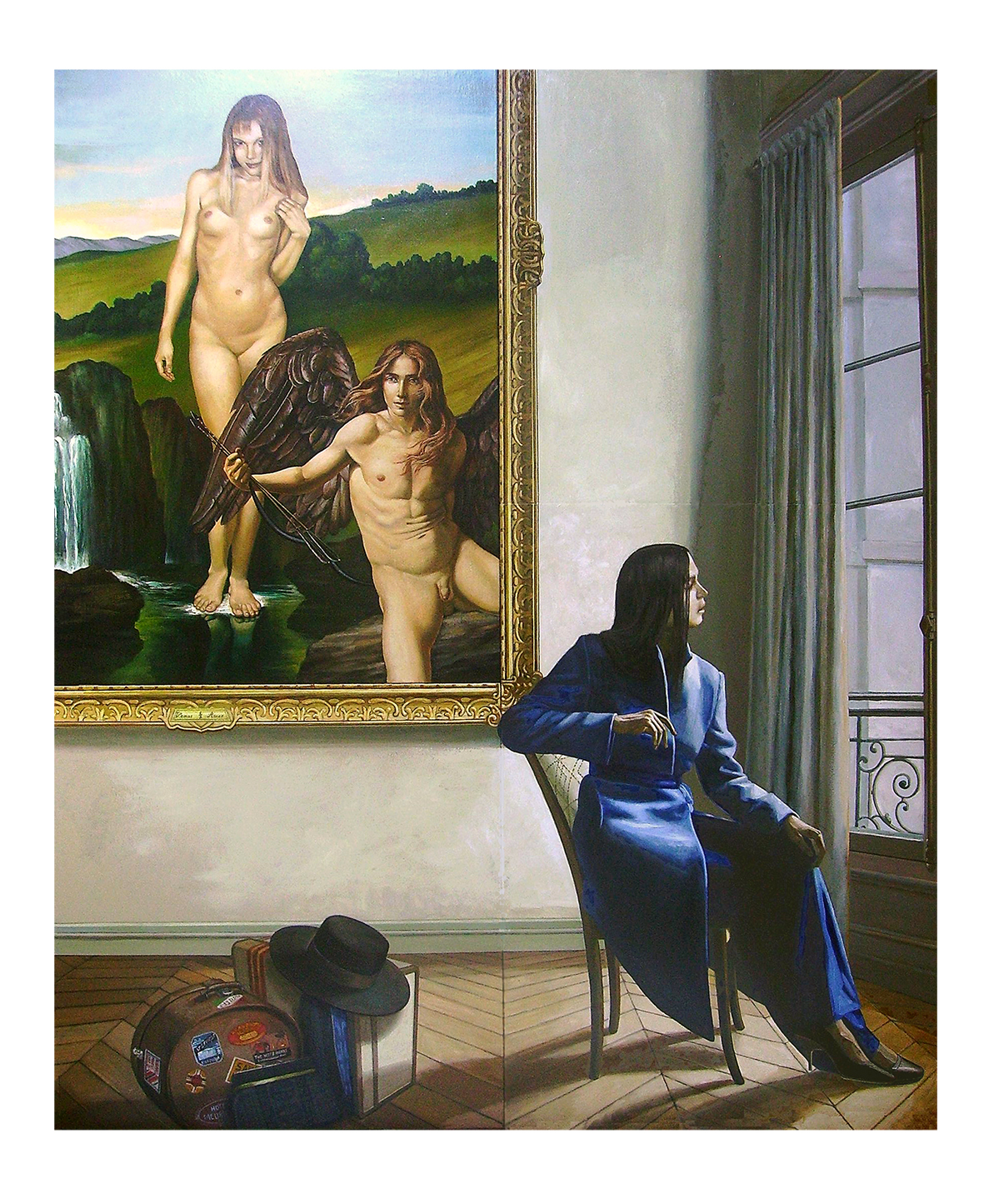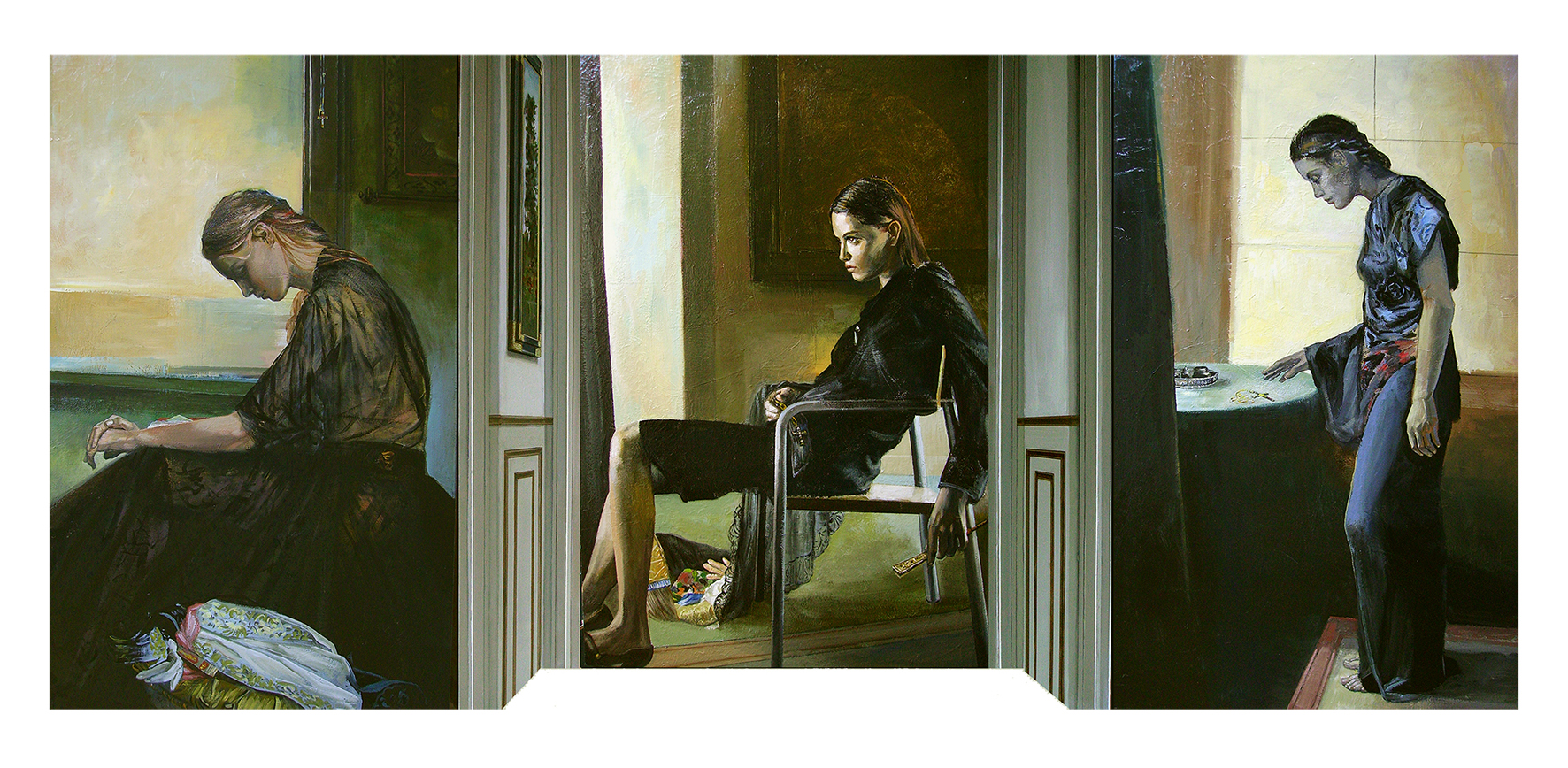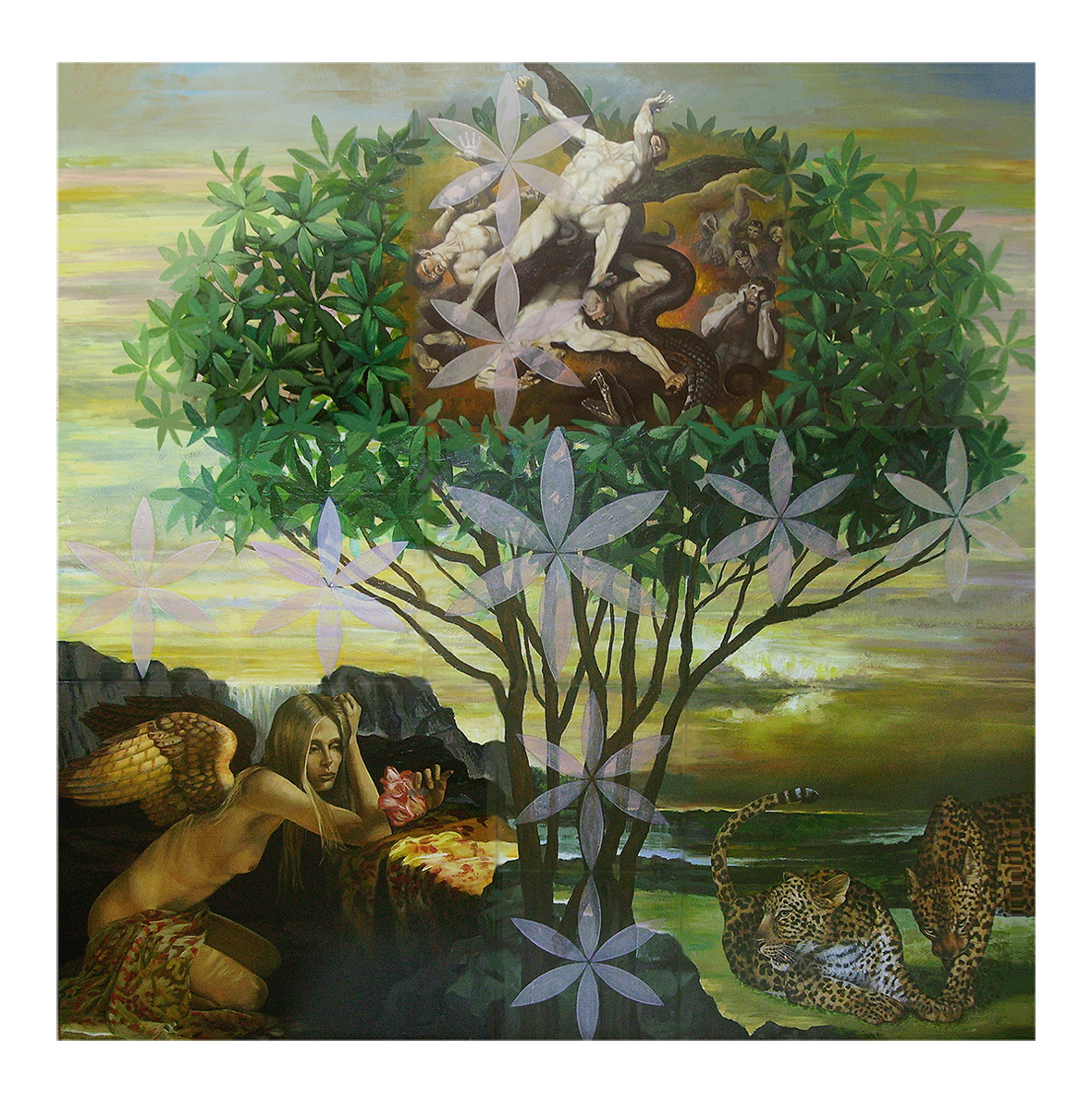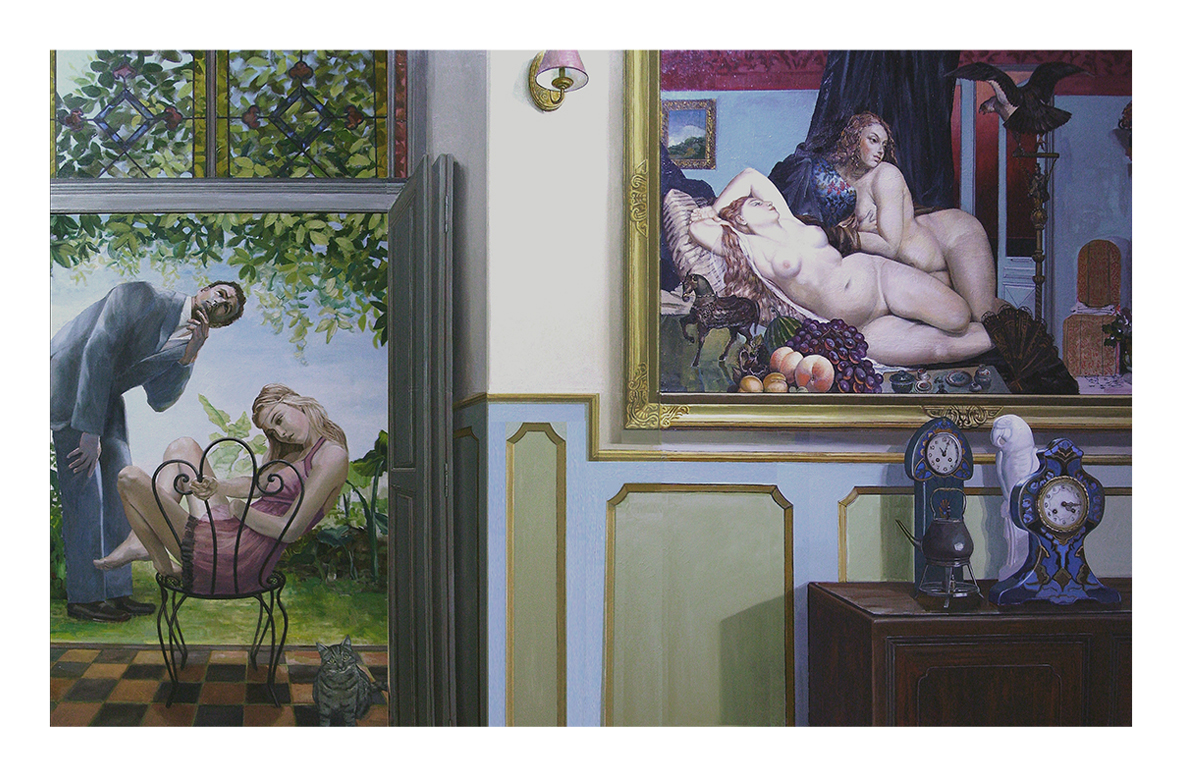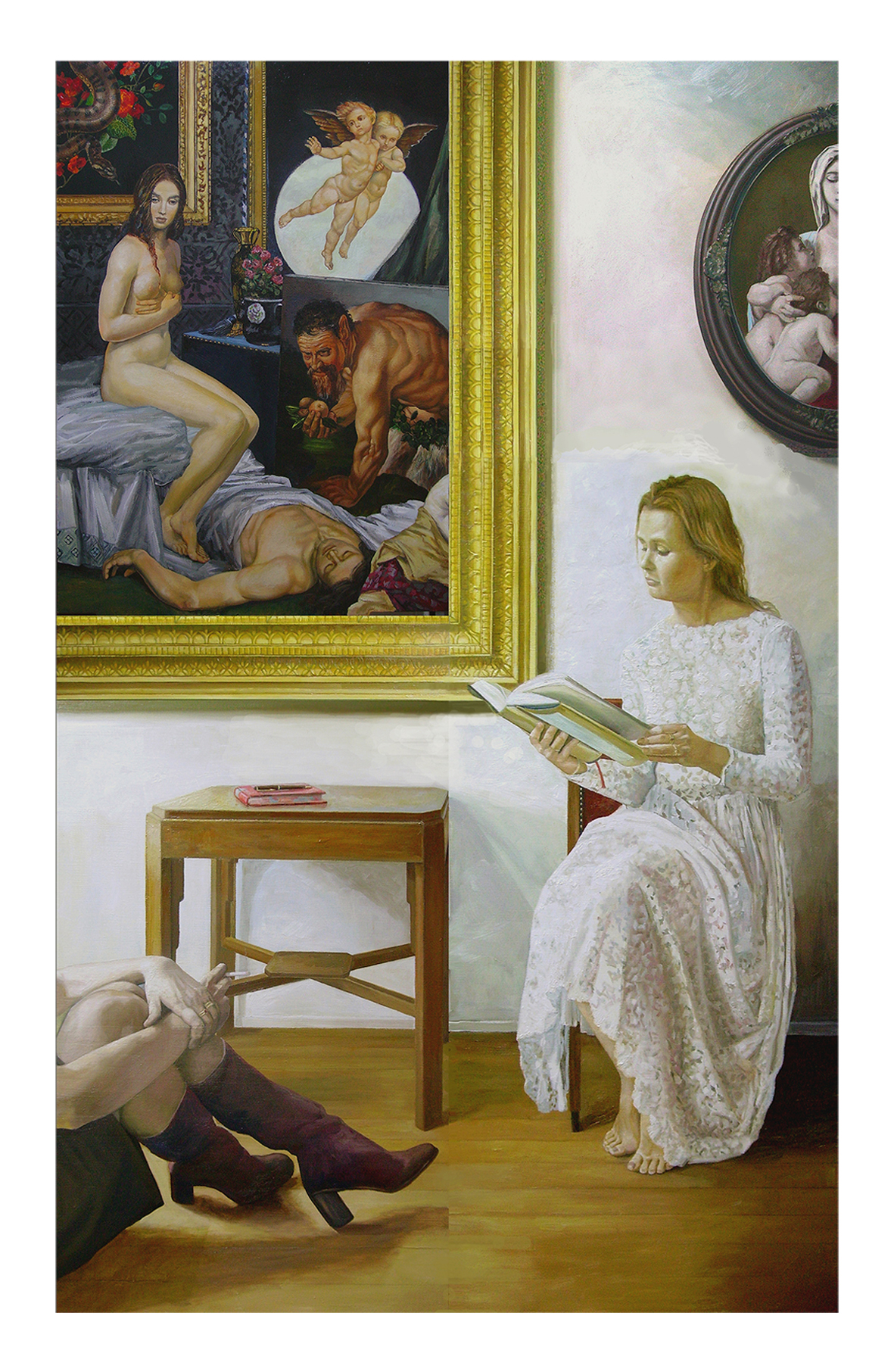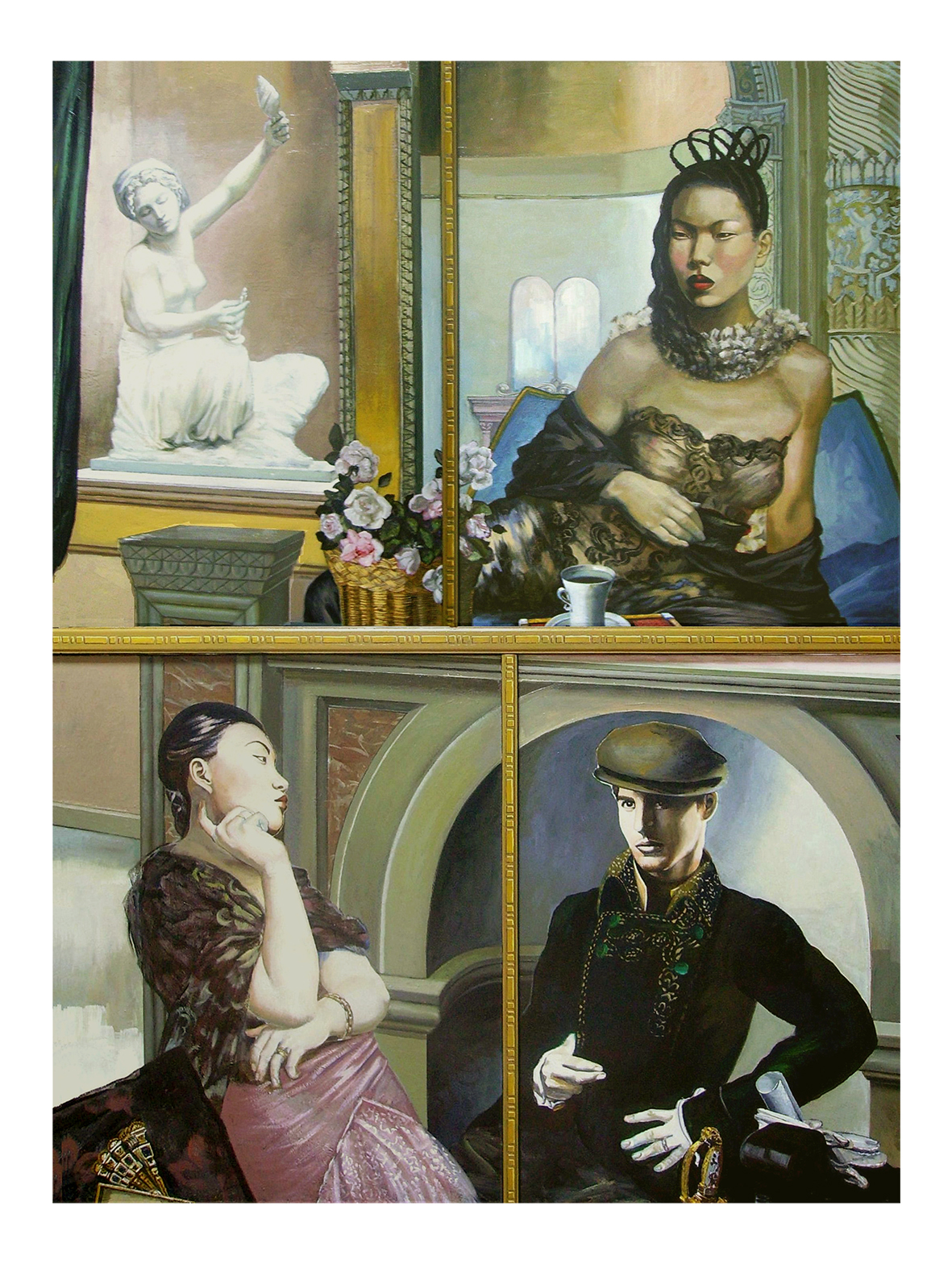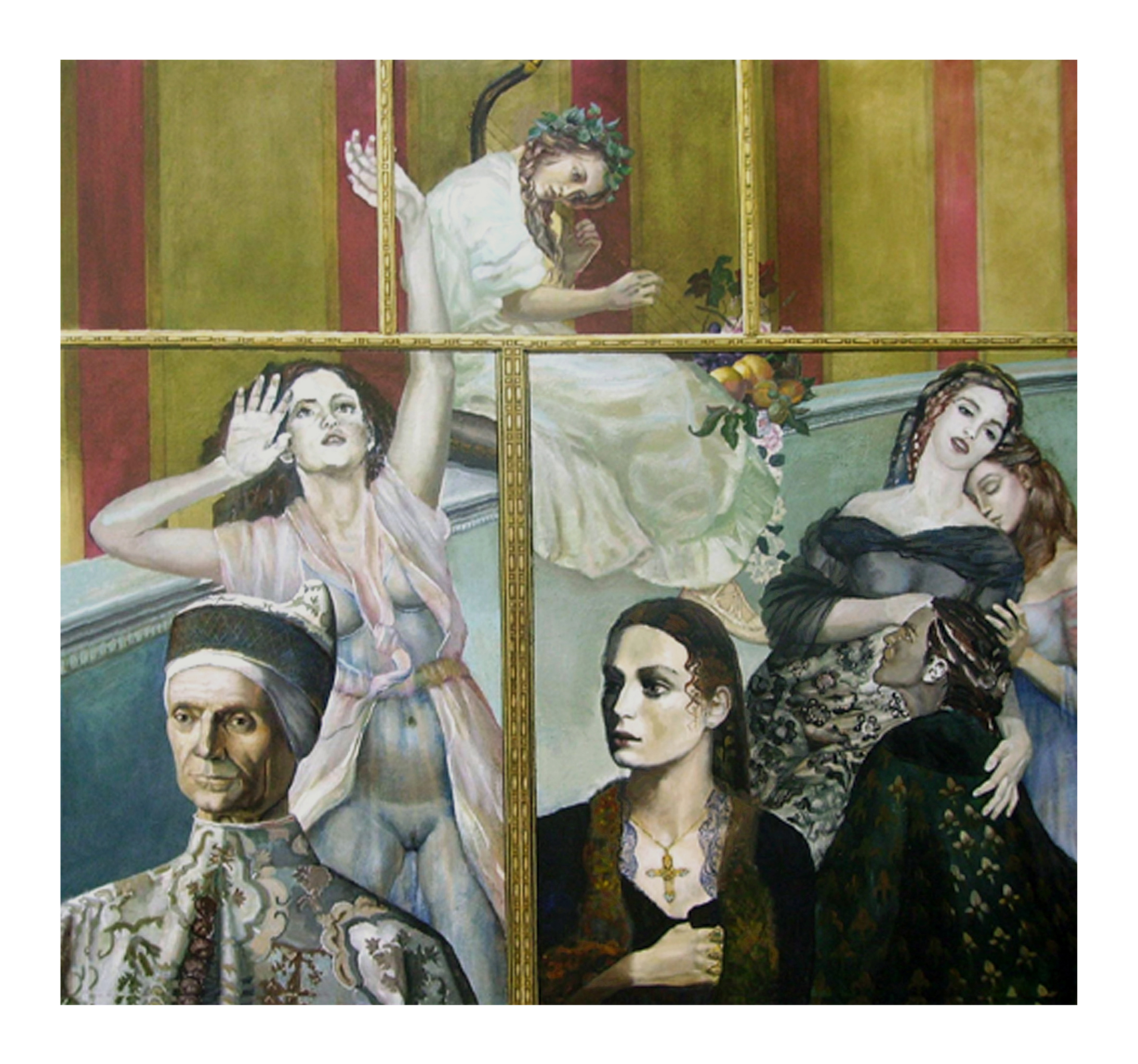vensters
2006 - 2008
CHILD DREAM (5.90 x 3.80m)
CHILD DREAM (5.90 x 3.80m)
Materials: Oil on canvas.
Symbolism: The Holy Cross. Crucifixion.
North: Chaos
The Ancient struggle before mankind. Law and order versus the uncontrolled forces of nature. Heaven and Hell.
West: Violence
The violence closely related to faith. Also a representation of Yang (male energy) and the Will to Power (Nietzsche).
Middle: Death
Dying Love. Also represents God is dead (Nietzsche).
East: Poetry
That what distinguishes us of the other primates. Also a symbol of Yin (female energy).
South: Innocence
Naivety. Religion has been reduced to windy skies and is diagnosed as mass psychoses. Reason awakes from the deep sleep. Peace can prevail.
The painting:
North: Greek: Struggle of the Titans. Titans versus supreme God Zeus. Christianity: Riders of the Apocalypse against God.
West: Achilles (utter left): Greek half God. The moment he has chosen for a peaceful existence as a musician, he is forced to reach to the arms. See the falling lyre (ancient musical instrument) and the sword. Perseus (with helmet): Greek half God. Warrior against evil. Son of supreme God Zeus & mortal Danaë, from immaculate conception. Comparable with God, Maria, Jesus.
Middle: Eros: Violence makes the Love God broken-winged. In the painting he crosses the river Styx to the realm of the dead. In the Greek myth an arrow of love penetrates his foot, which makes him in love with Psyche (female personification of the soul).
East: The Muses: Greek goddesses of singing, poetry, art and science. Victims of war. In her fall one of the muses pulls the love arrow out of the foot of Eros. Aphrodite (utter right): Greek goddess of fertility, love and beauty. Finds her origin in eastern myths. Also regarded as the mother of Eros.
South: The Children. They only see figures in the clouds and let their imagination flow. Dogmatism is still strange to them.
Materials: Oil on canvas.
Symbolism: The Holy Cross. Crucifixion.
North: Chaos
The Ancient struggle before mankind. Law and order versus the uncontrolled forces of nature. Heaven and Hell.
West: Violence
The violence closely related to faith. Also a representation of Yang (male energy) and the Will to Power (Nietzsche).
Middle: Death
Dying Love. Also represents God is dead (Nietzsche).
East: Poetry
That what distinguishes us of the other primates. Also a symbol of Yin (female energy).
South: Innocence
Naivety. Religion has been reduced to windy skies and is diagnosed as mass psychoses. Reason awakes from the deep sleep. Peace can prevail.
The painting:
North: Greek: Struggle of the Titans. Titans versus supreme God Zeus. Christianity: Riders of the Apocalypse against God.
West: Achilles (utter left): Greek half God. The moment he has chosen for a peaceful existence as a musician, he is forced to reach to the arms. See the falling lyre (ancient musical instrument) and the sword. Perseus (with helmet): Greek half God. Warrior against evil. Son of supreme God Zeus & mortal Danaë, from immaculate conception. Comparable with God, Maria, Jesus.
Middle: Eros: Violence makes the Love God broken-winged. In the painting he crosses the river Styx to the realm of the dead. In the Greek myth an arrow of love penetrates his foot, which makes him in love with Psyche (female personification of the soul).
East: The Muses: Greek goddesses of singing, poetry, art and science. Victims of war. In her fall one of the muses pulls the love arrow out of the foot of Eros. Aphrodite (utter right): Greek goddess of fertility, love and beauty. Finds her origin in eastern myths. Also regarded as the mother of Eros.
South: The Children. They only see figures in the clouds and let their imagination flow. Dogmatism is still strange to them.
HYLAS & THE NAIADS (1.90 x 1.60m)
HYLAS & THE NAIADS
(1.90 x 1.60m)
Materials: Oil on canvas.
Symbolism: Treacherous seduction. Treason.
Youthful Hylas is seduced by the Naiads and drowns. The Naiads or water nymphs were keepers of poetry, music and flowers. They lived near or in water.
The painting:
The viewer looks through glass in lead, colored, church windows to the ‘seduction’. Looking through the primary colors, that mixed in terms of light will produce white light and in terms of matter will produce black matter, like mixed paint.
In the oval there is the death mask of Hylas. The breadth – altitude proportions of a number of rectangles correspond with those of the Phi ratio or the Guilder cut: 1:1,618. In the Gothic arcs, parts of the flower of life are integrated. The painting itself is also a cheater of the eye, because it exists out of 12 small canvasses and one small panel. Moreover the picture can be dismantled and so to speak can be carried in a suitcase. In other words nothing in life is what it seems to be.
Materials: Oil on canvas.
Symbolism: Treacherous seduction. Treason.
Youthful Hylas is seduced by the Naiads and drowns. The Naiads or water nymphs were keepers of poetry, music and flowers. They lived near or in water.
The painting:
The viewer looks through glass in lead, colored, church windows to the ‘seduction’. Looking through the primary colors, that mixed in terms of light will produce white light and in terms of matter will produce black matter, like mixed paint.
In the oval there is the death mask of Hylas. The breadth – altitude proportions of a number of rectangles correspond with those of the Phi ratio or the Guilder cut: 1:1,618. In the Gothic arcs, parts of the flower of life are integrated.
The painting itself is also a cheater of the eye, because it exists out of 12 small canvasses and one small panel. Moreover the picture can be dismantled and so to speak can be carried in a suitcase. In other words nothing in life is what it seems to be.
THE SPECTATORS (3.00 x 2.00m)
THE SPECTATORS (3.00 x 2.00m)
Materials: Oil on canvas.
Symbolism: Indifference, Apathy, Cowardice.
Jesus said to him, “I tell you the truth, on this night, before the rooster crows, you will deny me three times.” Matthew 26:34
The painting:
The Spectators witness the fact that the little girl outdoors is molested by a swarm of cupids. The reflections of the witnesses are visible in the window. With rigid insensitive eyes they reflect their part to the viewer of the painting.
In the composition, the Fibonacci spiral is embedded. Series:
1 1 2 3 5 8 13 21 34 55 89…
The dimensions of the painting (2.00 x 3.00m) correspond with 2: 3.
Materials: Oil on canvas.
Symbolism: Indifference, Apathy, Cowardice.
Jesus said to him, “I tell you the truth, on this night, before the rooster crows, you will deny me three times.” Matthew 26:34
The painting:
The Spectators witness the fact that the little girl outdoors is molested by a swarm of cupids. The reflections of the witnesses are visible in the window. With rigid insensitive eyes they reflect their part to the viewer of the painting.
In the composition, the Fibonacci spiral is embedded. Series:
1 1 2 3 5 8 13 21 34 55 89…
The dimensions of the painting (2.00 x 3.00m) correspond with 2: 3.
THE MUSE & THE CASTLE IN THE AIR
(2.00 x 2.20m)
THE MUSE & THE CASTLE IN THE AIR (2.00 x 2.20m)
Materials: Oil on canvas.
Symbolism: From myth to logos. The struggle of culture versus nature. The archetype of the Muse
The Painting:
The woman has a lyre in her hands. A well-known instrument in Greek mythology. On this early version of the harp, Orpheus produced such enchanting sounds, that he had the old Greek world at his feet, likewise the woman in the painting her enchanted lover.
The painter looks through the window to his Muse. He is busy making her portrait. But what is he really looking at?
In science we travel progressively from myth to logos. Existential questions in which we define ourselves are no longer answered by the gods and the mysticism but are explained by science. Mythical proportions are shrinking. Our view at things change, even love is explained now, because clinically considered she is encouraged by pheromones, the scent of Eros.
Moreover, our culture and religion strive for monogamy, where our biology, from the point of view of surviving, strive for the spreading of genes.
Some windows do have proportions of the Phi ratio, also golden section or Guilder cut.
N.B.: Should the series of paintings be converted into resources, in order to make further development of painting possible, then the reflection of the painter will be made visible in the square window.
Materials: Oil on canvas.
Symbolism: From myth to logos. The struggle of culture versus nature. The archetype of the Muse
The Painting:
The woman has a lyre in her hands. A well-known instrument in Greek mythology. On this early version of the harp, Orpheus produced such enchanting sounds, that he had the old Greek world at his feet, likewise the woman in the painting her enchanted lover. The painter looks through the window to his Muse. He is busy making her portrait. But what is he really looking at?
In science we travel progressively from myth to logos. Existential questions in which we define ourselves are no longer answered by the gods and the mysticism but are explained by science. Mythical proportions are shrinking. Our view at things change, even love is explained now, because clinically considered she is encouraged by pheromones, the scent of Eros. Moreover, our culture and religion strive for monogamy, where our biology, from the point of view of surviving, strive for the spreading of genes.
Some windows do have proportions of the Phi ratio, also golden section or Guilder cut.
N.B.: Should the series of paintings be converted into resources, in order to make further development of painting possible, then the reflection of the painter will be made visible in the square window.
VENUS & AMOR (2.40 x 2.00m)
VENUS & AMOR (2.40 x 2.00m)
Materials: Oil on canvas.
Symbolism: The eternal farewell. Love inextricable linked with suffering.
…And I will put enmity between thee and the woman, and between thy seed and her seed…
Genesis 2,3
The Painting:
In the diagonal from the upper left to right below, we descent from the Greek to the Romans and eventually to the modern western culture.
The woman quietly has gathered her things and waits until the taxi arrives. Contemplating about her life she stares through the window, looking at a new world of relentless recurrence.
The mythological figures, the luggage and the lonely figure form a triangle, the strongest architectural construction that we know of.
In the picture it symbolizes: gathering, solitude and farewell.
The painting in the painting:
Venus was the Roman alternative of the Greek love goddess Aphrodite. Different from her Roman opponent, she not only was the Goddess of erotic love but also of charity and universal love. Amor was the Roman alternative of the Greek love god Eros.
The Greek: Aphrodite plays an important role in the realization of the eternal love between Psyche (personification of the soul, imagined as female beauty) and Eros.
The Romans: Venus let’s play Amor an important role in the romance between Dido (founder of Cartage) and Aeneas (Trojan hero, tribe father of Rome). Dido commit eventually suicide out of despair concerning the behavior of Aeneas.
The dimensions of the frame of the picture in the picture reveal only a part of the painting of Venus & Amor. As only a part of love can be visible. Also, can be deduced that the dimensions of the whole picture have to be 123,6 x 2,00cm (b x h), of which random, 140×100 cm is represented.
The breadth – altitude proportion: 123,6: 200 is similar to the Phi ratio.
Materials: Oil on canvas.
Symbolism: The eternal farewell. Love inextricable linked with suffering.
…And I will put enmity between thee and the woman, and between thy seed and her seed…
Genesis 2,3
The Painting:
In the diagonal from the upper left to right below, we descent from the Greek to the Romans and eventually to the modern western culture.
The woman quietly has gathered her things and waits until the taxi arrives. Contemplating about her life she stares through the window, looking at a new world of relentless recurrence.
The mythological figures, the luggage and the lonely figure form a triangle, the strongest architectural construction that we know of.
In the picture it symbolizes: gathering, solitude and farewell.
The painting in the painting:
Venus was the Roman alternative of the Greek love goddess Aphrodite. Different from her Roman opponent, she not only was the Goddess of erotic love but also of charity and universal love. Amor was the Roman alternative of the Greek love god Eros.
The Greek: Aphrodite plays an important role in the realization of the eternal love between Psyche (personification of the soul, imagined as female beauty) and Eros.
The Romans: Venus let’s play Amor an important role in the romance between Dido (founder of Cartage) and Aeneas (Trojan hero, tribe father of Rome). Dido commit eventually suicide out of despair concerning the behavior of Aeneas.
The dimensions of the frame of the picture in the picture reveal only a part of the painting of Venus & Amor. As only a part of love can be visible. Also, can be deduced that the dimensions of the whole picture have to be 123,6 x 2,00cm (b x h), of which random, 140×100 cm is represented.
The breadth – altitude proportion: 123,6: 200 is similar to the Phi ratio.
THE INHERITANCE (1.68 x 3.80m)
THE INHERITANCE (1.68 x 3.80m)
Materials: Oil on canvas.
Symbolism: The inheritance of religion, a time spirit or property, also referring to the original sin and the fall of man.
Unto the woman he said, I will greatly multiply thy sorrow and thy conception; in sorrow thou shalt bring forth children; and thy desire shall be to thy husband, and he shall rule over thee.
Genesis 2,3
Behold, I was shapen in iniquity; and in sin did my mother conceive me.
Psalm 51:5
The Painting:
Left we see the grandmother in her younger years. She represents old morality. Still fearing God. God has a central position likewise he had in the dark ages. To the right we see the daughter. In the meanwhile, the accent has been shifted from God to humanity. A shift which started during the Renaissance. In the middle there is the granddaughter, she seems indifferent of everything. The Holy Cross has changed to nothing more than a relic. Big money is now the Mammon.
The two outer paintings have the breadth – altitude proportions according to the Phi ratio or the Guilder cut and measure 100 x 161.8 cm; the dimensions of divine origin. Moreover, these paintings have more serene irradiation than the one in the middle. The central painting does not have the Guilder cut proportions and has not sunken in terms of perspective only, but also in depiction.
Materials: Oil on canvas.
Symbolism: The inheritance of religion, a time spirit or property, also referring to the original sin and the fall of man.
Unto the woman he said, I will greatly multiply thy sorrow and thy conception; in sorrow thou shalt bring forth children; and thy desire shall be to thy husband, and he shall rule over thee.
Genesis 2,3
Behold, I was shapen in iniquity; and in sin did my mother conceive me.
Psalm 51:5
The Painting :
Left we see the grandmother in her younger years. She represents old morality. Still fearing God. God has a central position likewise he had in the dark ages. To the right we see the daughter. In the meanwhile, the accent has been shifted from God to humanity. A shift which started during the Renaissance. In the middle there is the granddaughter, she seems indifferent of everything. The Holy Cross has changed to nothing more than a relic. Big money is now the Mammon.
The two outer paintings have the breadth – altitude proportions according to the Phi ratio or the Guilder cut and measure 100 x 161.8 cm; the dimensions of divine origin. Moreover, these paintings have more serene irradiation than the one in the middle. The central painting does not have the Guilder cut proportions and has not sunken in terms of perspective only, but also in depiction.
PARADISE LOST (2.70 x 2.70m)
PARADISE LOST (2.70 x 2.70m)
Materials: Oil on canvas.
Symbolism: The Fall of Man, after the novel Paradise Lost by John Milton (1608-1674), that tells about the disobedience of men and the loss of paradise, where in the middle of the garden the tree of life and the tree of knowledge of good and evil were planted.
The First sin: But of the fruit of the tree which is in the midst of the garden, God hath said, Ye shall not eat of it, neither shall ye touch it, lest ye die.
Genesis 2,3
The main cause of the destruction of men was the Devil, who persuaded Eve to eat the forbidden fruit, in spite of the explicit prohibition of God.
The Painting:
Upper middle: The Devil and his followers are excluded from heaven; they fall into the large abyss. Under we see Eve in Paradise at the moment she will soon be seduced by the Serpent to eat from the tree. The Archangel Gabriel tries to prevent this. His attempt of guarding people for their perdition will fail. The wings on Eve are the symbol of that fruitless attempt. But at this moment the predators are still tame and live side by side with men.
The seeds of life in the painting, existing out of six circles, symbolize the creation in six days. The symbol appears nine times in the image. The number nine stands both for perfection as infirmity and reflects earthly duality. Moreover, the nine is the last figure in our numerical system and represents in the numerology the line between earth and heaven. The dimensions of the canvas of the painting are a multiple of nine.
Gematria is the method to give Hebrew characters a number value. Because in the time of Moses separate signs for figures did not exist, therefore the characters were used. The 9th character, the Tet, means darkness, as the ninth plague for the Egyptians was darkness. Also refers to the 9 months darkness in the uterus. When Jesus died it was dark up to the ninth hour. Lukas 23:44: And it was on the sixth hour, and there became darkness over the earth until the ninth hour.
Both the first and the second temple was destroyed on the 9th day of the month. In the Torah, the word darkness occurs nine times. But above all the 9th character Tet means snake.
Materials: Oil on canvas.
Symbolism: The Fall of Man, after the novel Paradise Lost by John Milton (1608-1674), that tells about the disobedience of men and the loss of paradise, where in the middle of the garden the tree of life and the tree of knowledge of good and evil were planted.
The First sin: But of the fruit of the tree which is in the midst of the garden, God hath said, Ye shall not eat of it, neither shall ye touch it, lest ye die.
Genesis 2,3
The main cause of the destruction of men was the Devil, who persuaded Eve to eat the forbidden fruit, in spite of the explicit prohibition of God.
The Painting:
Upper middle: The Devil and his followers are excluded from heaven; they fall into the large abyss. Under we see Eve in Paradise at the moment she will soon be seduced by the Serpent to eat from the tree. The Archangel Gabriel tries to prevent this. His attempt of guarding people for their perdition will fail. The wings on Eve are the symbol of that fruitless attempt. But at this moment the predators are still tame and live side by side with men.
The seeds of life in the painting, existing out of six circles, symbolize the creation in six days. The symbol appears nine times in the image. The number nine stands both for perfection as infirmity and reflects earthly duality. Moreover, the nine is the last figure in our numerical system and represents in the numerology the line between earth and heaven. The dimensions of the canvas of the painting are a multiple of nine.
Gematria is the method to give Hebrew characters a number value. Because in the time of Moses separate signs for figures did not exist, therefore the characters were used. The 9th character, the Tet, means darkness, as the ninth plague for the Egyptians was darkness. Also refers to the 9 months darkness in the uterus. When Jesus died it was dark up to the ninth hour. Lukas 23:44: And it was on the sixth hour, and there became darkness over the earth until the ninth hour.
Both the first and the second temple was destroyed on the 9th day of the month. In the Torah, the word darkness occurs nine times. But above all the 9th character Tet means snake.
THE HAPPY FEW (2.00 x 3.20m)
THE HAPPY FEW (2.00 x 3.20m)
Materials: Oil on canvas.
Symbolism: Vanitas, perishable, conceited appearance, insatiable desire.
And to Adam he said: Because you have listened to the voice of your wife and have eaten of the tree of which I commanded you, ‘You shall not eat of it,’ cursed is the ground because of you; Genesis 2.
The Painting:
Left we see the annoyed spoiled girl and daddy who initially wants to chat with his daughter, but is distracted by the early fruit in the tree in front of the house. Nevertheless, deep inside he did not feel the urge for a good conversation anyway because he is already wasted.
The cat looks astonished to the viewer. He nor likes change nor newcomers. He is quite satisfied this way, in late spring in the garden. Right: In the decadent painting above the dresser, exuberance dominates. Two clocks tick the years away and give shape to mortality. The colorless parrot culture hides behind the time spirit.
The dimensions of the whole painting (2,00 x 3,20m) correspond to the Phi ratio, also golden section or Guilder cut. In de composition the Phi ratio spiral is embedded.
Materials: Oil on canvas.
Symbolism: Vanitas, perishable, conceited appearance, insatiable desire.
And to Adam he said,
Because you have listened to the voice of your wife and have eaten of the tree of which I commanded you, ‘You shall not eat of it,’ cursed is the ground because of you; Genesis 2.
The Painting:
Left we see the annoyed spoiled girl and daddy who initially wants to chat with his daughter, but is distracted by the early fruit in the tree in front of the house. Nevertheless, deep inside he did not feel the urge for a good conversation anyway because he is already wasted.
The cat looks astonished to the viewer. He nor likes change nor newcomers. He is quite satisfied this way, in late spring in the garden. Right: In the decadent painting above the dresser, exuberance dominates. Two clocks tick the years away and give shape to mortality. The colorless parrot culture hides behind the time spirit.
The dimensions of the whole painting (2,00 x 3,20m) correspond to the Phi ratio, also golden section or Guilder cut. In de composition the Phi ratio spiral is embedded.
THE ALTER EGO (3.20 x 2.00m)
THE ALTER EGO (3.20 x 2.00m)
Materials: Oil on canvas.
Symbolism: Duality. Double morality in general or double individuality in particular, like in still waters… also referring to the beginning of duality through the knowledge of good and evil and ambiguous Genesis traditions.
Genesis 1: 26-31 (The Creation)
Then God said: “Let us make man in our image, after our likeness. (…) So, God created man in his own image, in the image of God he created him; male and female he created them. And God blessed them. And God said to them, “Be fruitful and multiply and fill the earth and subdue it…
Genesis 2: 15-23 (Paradise)
The LORD God took the man and put him in the garden of Eden to work it and keep it. (…) Then the LORD God said, “It is not good that the man should be alone. I will make him a helper fit for] him.”(…) So the LORD God caused a deep sleep to fall upon the man, and while he slept took one of his ribs And the rib that the LORD God had taken from the man he made] into a woman and brought her to the man. Then the man said, “This at last is bone of my bones and flesh of my flesh; she shall be called Woman, because she was taken out of Man.
The Painting:
The serene woman in white reads to her tough Alter Ego. Of that other self she only can make a part visible. Moreover, that other one, that slumbers within, gives her an ambiguous feeling. She reads the book of John Milton (1606 -1674): Paradise Lost. The book is also full of contradictions. The painting above also refers to the novel. The painting on the right, representing unconditional love, is half visible.
The dimensions of the whole painting (2,00 x 3,20m) correspond to the Phi ratio, also golden section or Guilder cut. In de composition the Phi ratio spiral is embedded.
Materials: Oil on canvas.
Symbolism: Duality. Double morality in general or double individuality in particular, like in still waters… also referring to the beginning of duality through the knowledge of good and evil and ambiguous Genesis traditions.
Genesis 1: 26-31 (The Creation)
Then God said: “Let us make man in our image, after our likeness. (…) So, God created man in his own image, in the image of God he created him; male and female he created them. And God blessed them. And God said to them, “Be fruitful and multiply and fill the earth and subdue it…
Genesis 2: 15-23 (Paradise)
The LORD God took the man and put him in the garden of Eden to work it and keep it. (…) Then the LORD God said, “It is not good that the man should be alone. I will make him a helper fit for] him.”(…) So the LORD God caused a deep sleep to fall upon the man, and while he slept took one of his ribs And the rib that the LORD God had taken from the man he made] into a woman and brought her to the man. Then the man said, “This at last is bone of my bones and flesh of my flesh; she shall be called Woman, because she was taken out of Man.
The Painting:
The serene woman in white reads to her tough Alter Ego. Of that other self she only can make a part visible. Moreover, that other one, that slumbers within, gives her an ambiguous feeling. She reads the book of John Milton (1606 -1674): Paradise Lost. The book is also full of contradictions. The painting above also refers to the novel. The painting on the right, representing unconditional love, is half visible.
The dimensions of the whole painting (2,00 x 3,20m) correspond to the Phi ratio, also golden section or Guilder cut. In de composition the Phi ratio spiral is embedded.
ECHO & NARCISSUS
(1.80 x 2.20m)
ECHO & NARCISSUS
(1.80 x 2.20m)
Materials: Oil on canvas.
Symbolism: From logos to myth. The reaching back to old values in modern times.
As science moves forward, political and ethics tend to relentless recurrence. Learning nothing of the past. We free ourselves from God to turn later to the same metaphysical dogmas. Such as we travel from myth to logos, we continue traveling, from logos to myth and so on, within the circle of being.
The Painting:
In the painting the Greek myth revives. This time the tale of Echo & Narcissus stands symbol for reverting to the myth in uncertain times. Characterizing civilizations which undermine themselves, where the motivations of politicians are based on unbridled narcissism, deaf for reason or love. The composition is circularly and symbolizes the recurrence.
The Myth:
Narcissus was a young man of extraordinary beauty. The nymph Echo fell in love with him. When her love stayed unanswered, she perished until only her voice (echo) remained. As a sentence Aphrodite ensured that Narcissus became amorous on his own reflection in the water. Digested by a never satisfying love, he also perished and changed into the well known flower.
In the cross which symbolizes the disunion, the Phi ratio has been processed.
Materials: Oil on canvas.
Symbolism: From logos to myth. The reaching back to old values in modern times.
As science moves forward, political and ethics tend to relentless recurrence. Learning nothing of the past. We free ourselves from God to turn later to the same metaphysical dogmas. Such as we travel from myth to logos, we continue traveling, from logos to myth and so on, within the circle of being.
The Painting:
In the painting the Greek myth revives. This time the tale of Echo & Narcissus stands symbol for reverting to the myth in uncertain times. Characterizing civilizations which undermine themselves, where the motivations of politicians are based on unbridled narcissism, deaf for reason or love. The composition is circularly and symbolizes the recurrence.
The Myth:
Narcissus was a young man of extraordinary beauty. The nymph Echo fell in love with him. When her love stayed unanswered, she perished until only her voice (echo) remained. As a sentence Aphrodite ensured that Narcissus became amorous on his own reflection in the water. Digested by a never satisfying love, he also perished and changed into the well known flower.
In the cross which symbolizes the disunion, the Phi ratio has been processed.
IN THE SHADOW OF YOUNG GIRLS IN FLOWER
(2.06 x 1.53m)
IN THE SHADOW OF YOUNG GIRLS IN FLOWER (2.06 x 1.53m)
Materials: Oil on canvas.
Symbolism: Hypocrisy and hollow appearance, which leads eventually to confession and remorse.
Leviticus 18:22
And you shall not lie sexually with your neighbor’s wife and so make yourself unclean with her. You shall not give any of your children to offer them to Molech, and so profane the name of your God: I am the LORD. You shall not lie with a male as with a woman; it is an abomination.
The Painting:
The picture is inspired by a book of Marcel Proust, the 19th century novelist. According to the rumors in those days he was a homosexual. Sodomy was certainly in that century still a taboo at divine decree. Even regarded as a deadly sin. The viewer looks through the window to witness the famous French writer, bringing the demi monde (and easy virtue) a visit at Maison Chinoise. Especially in his books he seems to be attracted to women.
Materials: Oil on canvas.
Symbolism: Hypocrisy and hollow appearance, which leads eventually to confession and remorse.
Leviticus 18:22
And you shall not lie sexually with your neighbor’s wife and so make yourself unclean with her. You shall not give any of your children to offer them to Molech, and so profane the name of your God: I am the LORD. You shall not lie with a male as with a woman; it is an abomination.
The Painting:
The picture is inspired by a book of Marcel Proust, the 19th century novelist. According to the rumors in those days he was a homosexual. Sodomy was certainly in that century still a taboo at divine decree. Even regarded as a deadly sin. The viewer looks through the window to witness the famous French writer, bringing the demi monde (and easy virtue) a visit at Maison Chinoise. Especially in his books he seems to be attracted to women.
THE BACCHANAAL AT THE DODGE
(1.73 x 1.86m)
THE BACCHANAAL AT THE DODGE (1.73 x 1.86m)
Materials: Oil on canvas.
Symbolism: From religion to the Bacchanal, where the seven cardinal sins flourish, but ultimately lead to conversion.
The Painting:
The viewer looks through the window to a pyramid shaped form of seven figures. At the base the figures are still conservative. But nevertheless, freedom is increasing. Culminating in dance, debauchery and erotics.
Left under the statesman Doge Loredan is represented, after a painting of Giovanni Bellini, dated 1501.
For the first time in history the Venetian regent is represented frontal (en face) while mortals were merely portrayed en profil. The front view had been reserved for the holy matters. The Doge betrayed by the Pope finds support with the French king, symbolized by the French lilies on the cape of the figure under right. With this inversion of conceptions, the Renaissance or rebirth makes its entrance. The old Greeks are reintroduced and revive in art and culture. The shift from the God concept to the concept of man has begun. Dogmatic regulations are gradually abandoned.
However, the Doge stands also model for the first cardinal sin: Superbia, he does not submit himself to the dominating morality. The other figures make themselves more or less guilty to all seven sins.
Superbia (pride, arrogance)
Avaritia (greed, insatiability)
Luxuria (lust, desire)
Invidia (envy, jealousy)
Gula (gluttony, excess)
Ira (wrath, anger)
Acedia (sloth, laziness)
Materials: Oil on canvas.
Symbolism: From religion to the Bacchanal, where the seven cardinal sins flourish, but ultimately lead to conversion.
The Painting:
The viewer looks through the window to a pyramid shaped form of seven figures. At the base the figures are still conservative. But nevertheless, freedom is increasing. Culminating in dance, debauchery and erotics.
Left under the statesman Doge Loredan is represented, after a painting of Giovanni Bellini, dated 1501.
For the first time in history the Venetian regent is represented frontal (en face) while mortals were merely portrayed en profil. The front view had been reserved for the holy matters. The Doge betrayed by the Pope finds support with the French king, symbolized by the French lilies on the cape of the figure under right. With this inversion of conceptions, the Renaissance or rebirth makes its entrance. The old Greeks are reintroduced and revive in art and culture. The shift from the God concept to the concept of man has begun. Dogmatic regulations are gradually abandoned.
However, the Doge stands also model for the first cardinal sin: Superbia, he does not submit himself to the dominating morality. The other figures make themselves more or less guilty to all seven sins.
Superbia (pride, arrogance)
Avaritia (greed, insatiability)
Luxuria (lust, desire)
Invidia (envy, jealousy)
Gula (gluttony, excess)
Ira (wrath, anger)
Acedia (sloth, laziness)
THE CONVERSION OF MARIA M.
(3.15 x 3.00m)
THE CONVERSION OF MARIA M. (3.15 x 3.00)
Materials: Oil on canvas.
Symbolism: The church, the Apocrypha, the controversial role of Mary, the holy family and the liturgy.
The Painting:
Above: The Holy Family dressed in a modernistic way.
The interpretation changes along with the time spirit but intrinsically stays the same. So, at the same time Josef and Mary reflect, are imagined as, Adam and Eve. The source of the crusade. Disobedience which forced God to sacrifice his son. The man plays in a naive manner with the serpent and the woman turns away from the prohibited fruit, she has eaten from. She gets a mirror passed.
Anyone who listens to the word but does not do what it says is like a man who looks at his face in a mirror. James 1:23 The reflection is a symbol of duality. She knows of good and evil now and he was her accomplishment. A cupid shoots a love arrow. And Adam knew Eve his wife; and she conceived… Genesis 4:1. The divine comedy has started.
The rectangles in which the Holy Family is placed have the dimensions 0.5 x 1.618. Half the Phi ratio or Guilder cut proportion. So, the proportion is half divine and refers to Christ. Five is also the number of the Torah, 5 books and symbolize the Jewish – Christian world. Moreover, Christ himself was a Jew.
Under: The monks, moving in a flow through the house of God. The dimensions of the areas between the pillars, who support the Holy Family, are entirely in accordance with the Phi ratio. Unchanged divine proportions throughout the centuries. Paintings of monks of Andrea del Sarto (15/16th century), Zurbaran (16/17th cent.), Rembrandt (17th cent.) and Goya (18/19th cent.) have stand model for that immutability all over the centuries. The archetype of contemplation, dogmatism and liturgy.
Anyone who listens to the word but does not do what it says is like a man who looks at his face in a mirror. James 1:23 The reflection is a symbol of duality. She knows of good and evil now and he was her accomplishment. A cupid shoots a love arrow. And Adam knew Eve his wife; and she conceived… Genesis 4:1. The divine comedy has started.
The rectangles in which the Holy Family is placed have the dimensions 0.5 x 1.618. Half the Phi ratio or Guilder cut proportion. So, the proportion is half divine and refers to Christ. Five is also the number of the Torah, 5 books and symbolize the Jewish – Christian world. Moreover, Christ himself was a Jew.
Materials: Oil on canvas.
Symbolism: The church, the Apocrypha, the controversial role of Mary, the holy family and the liturgy.
The Painting:
Above: The Holy Family dressed in a modernistic way.
The interpretation changes along with the time spirit but intrinsically stays the same. So, at the same time Josef and Mary reflect, are imagined as, Adam and Eve. The source of the crusade. Disobedience which forced God to sacrifice his son. The man plays in a naive manner with the serpent and the woman turns away from the prohibited fruit, she has eaten from. She gets a mirror passed.
Anyone who listens to the word but does not do what it says is like a man who looks at his face in a mirror. James 1:23 The reflection is a symbol of duality. She knows of good and evil now and he was her accomplishment. A cupid shoots a love arrow. And Adam knew Eve his wife; and she conceived… Genesis 4:1. The divine comedy has started.
The rectangles in which the Holy Family is placed have the dimensions 0.5 x 1.618. Half the Phi ratio or Guilder cut proportion. So, the proportion is half divine and refers to Christ. Five is also the number of the Torah, 5 books and symbolize the Jewish – Christian world. Moreover, Christ himself was a Jew.
Under: The monks, moving in a flow through the house of God. The dimensions of the areas between the pillars, who support the Holy Family, are entirely in accordance with the Phi ratio. Unchanged divine proportions throughout the centuries. Paintings of monks of Andrea del Sarto (15/16th century), Zurbaran (16/17th cent.), Rembrandt (17th cent.) and Goya (18/19th cent.) have stand model for that immutability all over the centuries. The archetype of contemplation, dogmatism and liturgy.
Anyone who listens to the word but does not do what it says is like a man who looks at his face in a mirror. James 1:23 The reflection is a symbol of duality. She knows of good and evil now and he was her accomplishment. A cupid shoots a love arrow. And Adam knew Eve his wife; and she conceived… Genesis 4:1. The divine comedy has started.
The rectangles in which the Holy Family is placed have the dimensions 0.5 x 1.618. Half the Phi ratio or Guilder cut proportion. So, the proportion is half divine and refers to Christ. Five is also the number of the Torah, 5 books and symbolize the Jewish – Christian world. Moreover, Christ himself was a Jew.
